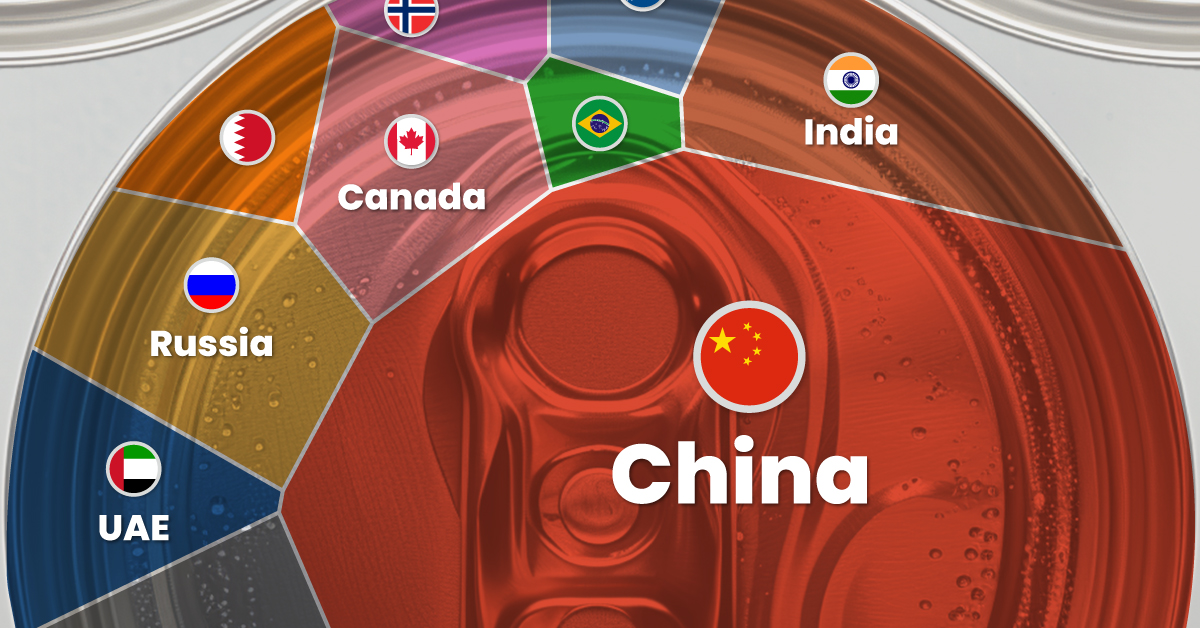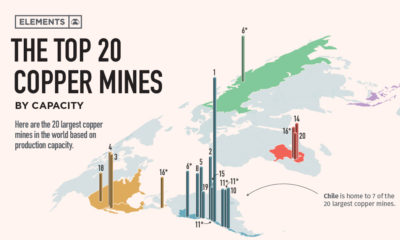Misc
How Metals Prices Performed in 2021
![]()
How Metals Prices Performed in 2021
Looking back on what gave investors strong returns in 2021, it was the year of industrial and energy metals.
As demand for industrial goods surged, so too did their material metals. But unlike energy prices which rose across the board last year, not all metals managed positive returns.
This infographic looks at the year-over-year return on metals prices from January 1 to December 31 of 2021, using pricing data tracked by Tradingeconomics.com.
Inflation and Raw Material Demand Spur Industrial Metals
Last year saw inflation hit 30-year highs as the world’s reopening resulted in unprecedented demand for base and energy metals.
Essential materials for electric vehicle (EV) battery production like lithium and cobalt were among the top performers as EV sales continued to grow in 2021.
| Metal | Annual Return in 2021 |
|---|---|
| Lithium | 496.7% |
| Magnesium | 207.6% |
| Cobalt | 115.2% |
| Tin | 93.6% |
| Molybdenum | 90.4% |
| Neodynium | 78.3% |
| Aluminum | 38.3% |
| Indium | 32.3% |
| Germanium | 31.7% |
| Gallium | 31.6% |
| Nickel | 29.4% |
| Zinc | 28.1% |
| Copper | 26.8% |
| Lead | 14.8% |
| Steel | 7.7% |
| Manganese | 7.2% |
| Gold | -3.5% |
| Platinum | -10.4% |
| Silver | -11.5% |
| Rhodium | -20.5% |
| Palladium | -22.0% |
| Iron ore | -24.0% |
Source: Tradingeconomics.com
Magnesium was another top performer last year, as skyrocketing coal prices impacted the metal, which uses coal as part of the feedstock in the smelting process. In addition, concerns over production suspensions in China for environmental reasons spurred magnesium prices further amidst potential shortage fears.
Iron ore was the only base metal with negative returns, with demand largely curbed by China’s slowing growth and pledge to reduce steel output in May of last year.
Lithium and Other EV Metals Outperform
Last year saw major automakers like Ford and GM commit themselves to all new car sales being zero emission by 2040, spurring an 80% rise in electric vehicle sales in 2021.
As a result, essential battery metals like lithium, cobalt, lead, and nickel were all in high demand as automakers secured these essential materials for their battery production.
The start of 2022 has also seen more positive catalysts for nickel specifically, as Tesla secured a supply deal with Talon Metals for 75,000 tonnes of nickel concentrate over six years.
PGM Prices Falter
Palladium and platinum had strong starts in the first half of the year as well, but chip shortages resulted in a slowdown in automotive production and a drop in demand for the two metals.
Both of these key platinum group metals (PGMs) finished 2021 with double-digit drawdowns, with platinum returning -10.4% and palladium returning -22.0%.
Metals analysts are mixed on whether the two metals (primarily used in automotive catalytic converters) will see a recovery in demand, which would be led by easing chip shortages and supply chain issues.
Gold and Silver Struggle to Hold Value
As the world focused on securing the necessary raw materials for the clean energy transition, gold and silver lagged behind.
Although both precious metals wavered as stores of value, returning -3.5% and -11.5% respectively, bullion sales from the U.S. mint rose by 48.4% compared to 2020.
Despite gold’s underwhelming performance while equities, cryptocurrencies, and other commodities surged, upcoming forecasted rate hikes have historically spurred reversals for the precious metal.
As 2022 has started with equity prices slumping, a potential flight to the safety of hard assets and the continuous demand for raw materials needed for the clean energy transition could set up a positive 2022 for metals.
Misc
Visualizing Global Aluminum Production
China dominates global production with nearly 60% share.

Visualizing Global Aluminum Production
This was originally posted on our Voronoi app. Download the app for free on iOS or Android and discover incredible data-driven charts from a variety of trusted sources.
This infographic shows estimated aluminum smelter production by country in 2023, based on data from the most recent U.S. Geological Survey (USGS) Mineral Commodity Summaries, published in January 2024 .
From this data, we can see that China leads as the top producer, accounting for nearly 60% of the world’s smelter capacity. Its neighbor India is the second-largest producer, making only a tenth of China’s output.
| Country | 2023 Aluminum Smelter Production (tonnes) | % of total |
|---|---|---|
| 🇨🇳 China | 41,000,000 | 59% |
| 🇮🇳 India | 4,100,000 | 6% |
| 🇷🇺 Russia | 3,800,000 | 5% |
| 🇨🇦 Canada | 3,000,000 | 4% |
| 🇦🇪 United Arab Emirates | 2,700,000 | 4% |
| 🇧🇭 Bahrain | 1,600,000 | 2% |
| 🇦🇺 Australia | 1,500,000 | 2% |
| 🇳🇴 Norway | 1,300,000 | 2% |
| 🇧🇷 Brazil | 1,100,000 | 2% |
| 🌍 Rest of the World | 9,460,000 | 14% |
| Total | 69,560,000 | 100% |
Responsible for 5% of global aluminum output, Russia has been targeted by recent sanctions from the U.S. and the UK.
The sanctions include prohibiting metal-trading exchanges from accepting new aluminum produced by Russia and barring the import of the Russian metal into the U.S. and Britain. The actions are aimed at disrupting Russian export revenue amid Moscow’s ongoing invasion of Ukraine.
The World’s Most Common Metal
Aluminum is the primary material used for making cans, foil, and many other products. It originates from bauxites, rocks composed of aluminum oxides, and various minerals.
Approximately 25% of annually produced aluminum is utilized by the construction industry, while another 23% is allocated to vehicle frames, wires, wheels, and other components within the transportation sector. Aluminum foil, cans, and packaging constitute another significant end-use category, accounting for 17% of consumption.
Despite its extensive use, aluminum is still plentiful. Aluminum is the world’s most common metal by crustal abundance, making up 8.2% of the Earth’s crust.
According to the USGS, global resources of bauxite are estimated to be between 55 billion and 75 billion tonnes and are sufficient to meet world demand for metal well into the future.
Misc
Brass Rods: The Sustainable Choice
Brass rods can help cut emissions in machine shops, be recycled without losing properties, and contribute to a cleaner environment.

Brass Rods: The Sustainable Choice
Brass rods have a powerful lineup of green attributes, making them the sustainable choice for manufacturers and end-users of precision machined and forged parts.
This infographic, from the Copper Development Association, shows how brass rods can reduce emissions in machine shops, be recycled without losing properties, and contribute to a cleaner environment.
The Brass Rod Circular Economy
The metallurgical properties of brass allow pre- and post-consumer sources of brass scrap to be recycled with no loss in properties.
Brass scrap can retain over 90% of the original material value. In addition, brass doesn’t need energy-intensive processing, unlike steel and aluminum, which must be smelted and refined before being recycled into new products.
As a result, there is a greater chance that steel and aluminum scrap will end up in landfills.
Most brass-rod alloys produced in North America contain 95% or higher recycled content.
Closed-loop recycling of brass keeps this valuable engineering material out of landfills, reducing the need for new mines and all the environmental impacts that entails.
Higher Machinability Leads to Lower Operational Carbon Emissions
Machinability is how easily a material can be worked using cutting processes. It directly impacts the amount of energy required to produce finished parts.
With typical machine shops producing millions of parts each year, the carbon impact can be significant.
Here’s how brass and steel compare when manufacturing complex parts using computer numerical control (CNC) machining.
| Material | Brass | Steel |
|---|---|---|
| Type | Free-cutting brass (C36000) | Free-cutting steel (12L14) |
| Maximum machinability rating (0-100) | 100 | 21 |
| Metal Removal Rate (cubic inches per minute) | 0.238 | 0.114 |
| Time to remove material (hours) | 161,111 | 336,111 |
| Energy required to produce parts (kilowatt-hour) | 9,475 | 18,931 |
In this example, using brass represented a savings of 3,510 kg in carbon dioxide (CO2).
The significantly longer tool life enabled by brass also reduces the need for new cutting tools, further decreasing emissions.
High recycled content and exceptional machinability make brass rods the sustainable choice for manufacturers and end-users seeking to reduce their environmental footprint and support the transition to a low-carbon future.
Explore the advantages of brass rod solutions.
-

 Electrification3 years ago
Electrification3 years agoRanked: The Top 10 EV Battery Manufacturers
-

 Electrification2 years ago
Electrification2 years agoThe Key Minerals in an EV Battery
-

 Real Assets3 years ago
Real Assets3 years agoThe World’s Top 10 Gold Mining Companies
-

 Electrification3 years ago
Electrification3 years agoMapped: Solar Power by Country in 2021
-

 Misc3 years ago
Misc3 years agoAll the Metals We Mined in One Visualization
-

 Energy Shift2 years ago
Energy Shift2 years agoWhat Are the Five Major Types of Renewable Energy?
-

 Electrification2 years ago
Electrification2 years agoThe World’s Largest Nickel Mining Companies
-

 Misc3 years ago
Misc3 years agoThe Largest Copper Mines in the World by Capacity



















